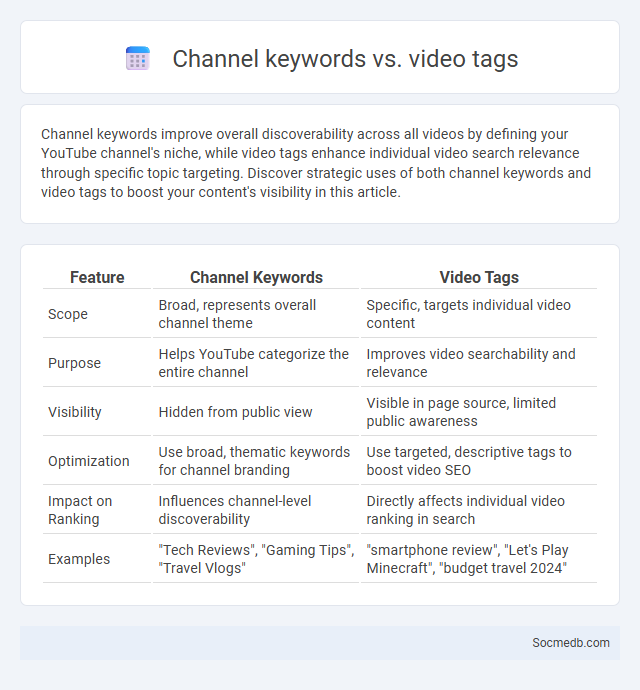
Photo illustration: channel keywords vs video tags
Channel keywords improve overall discoverability across all videos by defining your YouTube channel's niche, while video tags enhance individual video search relevance through specific topic targeting. Discover strategic uses of both channel keywords and video tags to boost your content's visibility in this article.
Table of Comparison
| Feature | Channel Keywords | Video Tags |
|---|---|---|
| Scope | Broad, represents overall channel theme | Specific, targets individual video content |
| Purpose | Helps YouTube categorize the entire channel | Improves video searchability and relevance |
| Visibility | Hidden from public view | Visible in page source, limited public awareness |
| Optimization | Use broad, thematic keywords for channel branding | Use targeted, descriptive tags to boost video SEO |
| Impact on Ranking | Influences channel-level discoverability | Directly affects individual video ranking in search |
| Examples | "Tech Reviews", "Gaming Tips", "Travel Vlogs" | "smartphone review", "Let's Play Minecraft", "budget travel 2024" |
Understanding Channel Keywords: Definition and Importance
Channel keywords refer to the specific terms and phrases used within social media platforms to categorize and optimize content visibility. Understanding channel keywords is crucial for enhancing engagement, as these keywords improve searchability and target the right audience demographic. Effective use of channel keywords drives organic reach and boosts overall social media marketing performance.
What Are Video Tags? Role and Functionality
Video tags are keywords or phrases added to your social media videos to improve discoverability and enhance search engine optimization (SEO). These tags categorize your content, making it easier for platforms like YouTube, Instagram, and TikTok to recommend your videos to the right audience. Using relevant video tags increases your chances of reaching targeted viewers and boosting overall engagement on your social media channels.
Metadata Explained: A Comprehensive Overview
Metadata in social media refers to the descriptive information embedded in posts, images, videos, and profiles that aids in organizing, searching, and analyzing content. This includes timestamps, geolocation, user interactions, hashtags, and content type, which platforms use to enhance user experience and target advertising. Understanding metadata allows marketers and users to optimize content visibility, engagement, and personalized recommendations efficiently.
Key Differences Between Channel Keywords and Video Tags
Channel keywords enhance your overall social media profile visibility by targeting broad topics related to your niche, while video tags focus on optimizing individual video content for specific search queries. Channel keywords help categorize your entire channel across platforms like YouTube or Instagram, improving discoverability over time. Video tags allow you to tap into trending or highly searched terms tailored to each piece of content, increasing immediate engagement and reach.
Impact of Metadata on Video Discoverability
Metadata plays a crucial role in enhancing the discoverability of videos on social media platforms by providing detailed information such as titles, descriptions, tags, and timestamps that help algorithms accurately categorize and index content. Optimizing your video's metadata ensures it reaches the right audience, boosting visibility and engagement rates. Carefully crafted metadata increases the likelihood that your videos appear in relevant search results and recommended feeds, amplifying your social media presence.
How to Optimize Channel Keywords for Better Reach
Optimizing channel keywords involves conducting thorough research using tools like Google Keyword Planner and YouTube Analytics to identify high-volume, relevant terms that align with your content niche. Incorporate these keywords naturally into your channel description, video titles, tags, and metadata to improve discoverability through search engines and platform algorithms. Regularly update and analyze keyword performance metrics to refine targeting strategies and maximize audience engagement and reach.
Best Practices for Choosing Video Tags
Selecting effective video tags involves using relevant keywords that accurately describe the content, boosting your video's visibility in search results. Incorporate a mix of broad and specific tags to capture diverse search intents and improve discoverability across different audience segments. Regularly analyze tag performance with analytics tools to refine your strategy and enhance engagement.
The Role of Metadata in Video Ranking
Metadata plays a crucial role in video ranking on social media platforms by providing essential information such as titles, tags, descriptions, and timestamps that help algorithms understand content context and relevance. Optimizing your video's metadata enhances discoverability, increasing the chances of higher ranking in search results and recommendation feeds. Leveraging accurate and detailed metadata ensures Your videos reach the right audience, driving better engagement and growth.
Common Mistakes in Using Keywords, Tags, and Metadata
Common mistakes in using keywords, tags, and metadata on social media include overstuffing with irrelevant or excessive keywords, which can lead to lower search rankings and reduced engagement. You should ensure tags and metadata are specific, accurately reflecting your content to improve discoverability and reach the right audience. Proper optimization of these elements enhances your content's visibility and drives meaningful user interaction.
Strategic Integration: Balancing Keywords, Tags, and Metadata
Strategic integration of keywords, tags, and metadata enhances social media visibility by improving content discoverability and engagement metrics. Optimizing these elements according to platform algorithms ensures targeted reach and boosts organic traffic. Consistent analysis and adjustment of keyword relevance and tag effectiveness maximizes audience targeting and strengthens brand presence.
 socmedb.com
socmedb.com